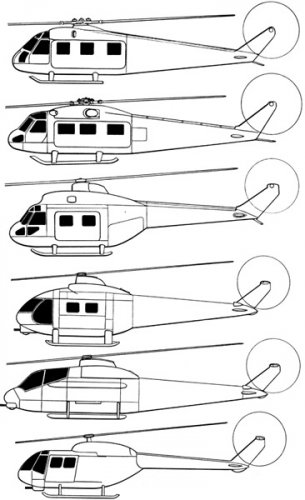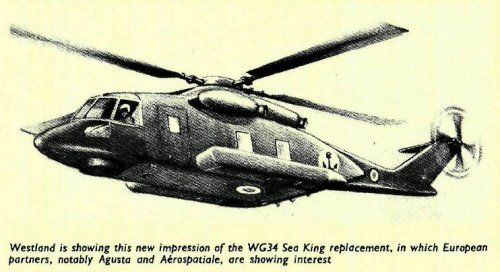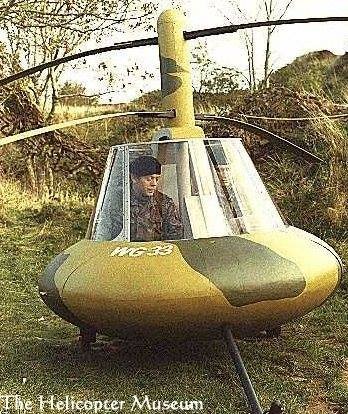Westland Group 'WG' Series Aircraft Designations
WG.1 -- (Project) 1962/63 HLH derived from licenced* V-107, to OR.358
- WG.1: Derived from earlier Westonian Mk.2 studies, May-July 1963
- WG.1: 4 x 1,600 shp R-R H.1600
Gnome turboshafts**
- WG.1: Alt., 3 x 1,600 shp R-R H.1600
Gnome turboshafts
- WG.1: Alt., 2 x 2,700 shp General Electric T64-GE-4 turboshafts
- WG.1: 3 + 33 troops, 35,740 lb MGW, 51' long, dropped in favor of
Chinook/
Sea King
-- * Licence for the
Chinook bought around same time by Agusta-owned Meridionali
-- **
Gnomes grouped in external pairs (in contrast with 'buried' V-107 arrangement)
WG.2 -- (??)
WG.3 -- (Project) 1960 light tactical helicopter (
Whirlwind repl.), 2 + 10 troops
- WG.3 layout approx. miniature
Sea King - engines above cockpit, sloping fuse.
- WG.3A: 2 x 720 shp P&WC PT6, TO wt 3600 kg, external load to 3000 lb
-- As orig. proposed, PT6s drove mod.
Whirlwind gearbox &
Belvedere rear rotor
--
http://www.flightglobal.com/pdfarchive/view/1974/1974 - 1301.html
- WG.3B:
Sycamore gearbox (in place of WG.3A's Whirlwind transmission)
-- NB: WG.3A and WG.3B scaled to fit into RAF
Hercules or AW.681 cargo holds*
-- * Requiring folding main rotor blades and/or detachable undercarriage skids
- WG.3C: 2 x 1200 shp R-R
Gnome, 15 troops, 5 tons, ext'l load 4000 lb Land Rover
-- WG.3C consid. overpowered; project reverted to PT6, becoming WG.13 (qv)
WG.4 -- (Project) medium logistic & ASW helicopter (
Wessex repl.), 2 + 24 troops
- WG.4: 2 x 1200 shp R-R
Gnome (??), single rotor, gross weight 17,000 lb.
WG.5 -- [Project] 1963 light multi-purpose 3-seat LOH/'squad carrier' (
Scout repl.)
- WG.5: single-engined [PT6?], 2,400 lb; succeeded by 4-seat WG.12 project (qv)
WG.6 -- 1955
Westminster PV military/civil HLH, 2 x 2,920 shp Napier
Eland E.229A
--
Westminster based on licensed Sikorsky S-56 rotors, gearbox, & control system
- WG.6: 1956
Westminster Flying Test Rig (with steel-tube fuselage framework)
- WG.6: (Project) 1955, 40 pax civil transport, 100 mi range, cabin mockup built
--
Westminster civil cabin layout: 8 rows of 5 abreast (luggage racks above)
- WG.6: (Project) 1955, flying crane (under-slung loads/pods & outsized cargo)
-- WH.6 flying crane to lift 15,000 lb load, up to fifty-one troops, or 4 x Jeeps
--
http://www.secretprojects.co.uk/forum/index.php/topic,11931.0.html
WG.7 -- (Project) Mid-1963 medium military logistic helicopter
- WG.7: single-rotor helicopter to OR.365, developed from WG.4
- WG.7: 2 x (??) shp R-R (??)
Gnome, 12,500 lb (??)
- WG.7A - (??) no details
- WG.7B - (??) no details
- WG.7C - (??) no details
- WG.7D - (??) no details
- WG.7E - 14,000 lb, take-off weight
- WG.7F - (??) no details
- WG.7G - 15,500 lb, take-off weight
-- Aérospatiale
Puma adopted for this role
WG.8 -- (? Project ?) possibly an enlarged version of the WG.4 project (??)
WG.9 -- (??)
WG.10 - (??)
WG.11 - (Project) 1965 WG.1 derivative transport helicopter with canard wings
- WG.11: 4 x 1,200 shp Rolls-Royce (??)
Gnome turboshaft engines*
- WG.11 military version: short canards/wings/fuselage, to NASR.358 trans./ASW
- WG.11 civil version: 60 pax, 12' fuselage extension (comp. with military WG.11)
--
http://www.flightglobal.com/pdfarchive/view/1967/1967 - 1335.html
-- *
Gnome turboshafts paired on either side of fuselage (as per WG.1 layout)
-- WG.11 abandoned when
Chinook chosen for Army/RAF and
Sea King for Royal Navy
WG.12 - (Project) 1965 successor to the WG.5 LOH project, 4 seats, 2,500 lb gross
- WG.12 abandoned when Aérospatiale
Gazelle chosen instead for British services
WG.13 - 1964, refined WG.3, 8,000 lb. (
Whirlwind/
Wasp repl.), becomes
Lynx
- WG.13: PT6 forward-placed engines, higher cabin, pod-and-boom fuselage
- WG.13D: (following WG.3C) 1965 to GSOR 3335 multipurpose 3 + 7 Army helo
-- WG.13 orig. rotor diameter 49' 4" dictated by avail. engine power (720 shp)
- WG.13Q: utility vers., rear-placed 2 x 770 shp Continental T72,* nose turret
-- * 'Stretched'
Astazou (T72 progenitor) considered for added French content
- WG.13R: tandem 2-seat armed escort version, 2 x 770 shp T72s, nose turret
- WG.13S: combined utility/ armed escort version, 2 x T72s, dev. abandoned
-- 1966 WG.13 naval vers. devel. prompts a rotor diameter reduction to 44'
- WG.13T: armed reconnaissance version, 2 x 770 shp Continental T72s
- WG.13U: revised utility vers., 2 x 770 shp T72s, narrower tail boom
- WG.13W: revised civil vers., T72s, narrower tail boom, rounded nose
-- 1967 French Navy req. dictates further rotor diam. reduction to 42'
- WG.13X: revised utility vers., smaller rotor, semi-rigid hub, 2 x BS.360**
-- ** 900 shp Bristol Siddeley BS.360 becomes Rolls-Royce RS.360 then R-R
Gem
- WG.13[?]: wheeled maritime vers. for RN FFH/DDH and France's
Aéronavale***
--- *** Due to initial
Gem limitations,
Aéronavale consid. alt. PT6s until 1972
- WG.13(?): (Project)
Armée de Terre attack deriv., 30mm gun, low-set wings
-- WG.13 gunship tandem 2-seat, French wanted 3-seater, abandoned Oct 1969
--
http://www.flightglobal.com/pdfarchive/view/1968/1968 - 0705.html
--
http://www.secretprojects.co.uk/forum/index.php/topic,975.msg124001.html
- WG.13(?): (Project) 1970 PT6-powered vers. considered for N. American sales
-- PT6-powered WG.13 revived 1974 to increase North American sales potential
- WG.13(?): (Project) 1971 12-pax civil vers.**** with 18" cabin stretch
-- **** Stretched civil WG.13 to be in service by 1975, replaced by WG.30 (qv)
- NB: The first WG.13
Lynx (XW835) flew 21 March 1971. All production
Lynx appear to have generic WG.13 factory designation without suffix letters (Srs and/or mark numbers being used to distinguish
Lynx variants)
WG.14 - (??)
WG.15 - (Project) 197? tilt-wing twin-rotor inter-city airliner
WG.16 - (Project) 197? asymmetrical* 10 ton-lift helicopter crane
- WG.16: Tip-jet driven rotor, empty weight 7,000 lb
-- * Cabin pod offset to port, tail rotor boom offset to starboard
WG.17 - (Project) Further development of WG.11 concept as a compound helicopter
-- WG.17 : Stretched compared with WG.11, multiple powerplants/types
- WG.17A: (??)
- WG.17B: (??)
- WG.17C: (??)
- WG.17D - 138-pax, 4 x GE T64-GE-16 + 2 x BS M45H turbofans, rear ramp
-- WG.17D stretched compared with WG.11, M45H turbofans over wings, buried T64s
WG.18 -- (Project) 19??
Six compound helicopter
- WG.18: Short-range military transport helicopter
- WG.18: 2 x turboshafts, 4 x propeller-turbines
WG.19 - (??)
WG.20 - (??)
WG.21 - (Project) 1970 2-seat ground attack tilt-engine a/c, 2 x turboshafts*
- WG.21: initial design - straight-winged tilt-rotor, under-nose cannon turret
-- WG.21 rotor diameter 37.5 ft, length 41 ft, TO wt 22,000-26,000 lb, 530 kt
-- WG.21 derived from Westland's work on WE-01 6-8 seat tilt-rotor a/c project
- WG.21: later design concept - swept-winged tilt-wing, nose-mounted cannon
-- * 2 x RR Snecma M45 turboshaft (RB.411?) or 5,000 shp Avco Lycoming LTC4V-1
--
http://www.secretprojects.co.uk/forum/index.php/topic,324.msg104785.html#msg104785
WG.22 - (Project) tilt-wing VTOL 100-pax intercity airliner, 4 x 9450 shp* turboshafts**
-- * 6,580 shp normal rating, NB: Flight lists 9000 shp, other sources only 7000 shp
-- ** RR RB.411-01 or Lycoming LTC4V-4 turboshaft engines, mounted in pairs
-- NB: RB.411 was the Rolls-Royce version of Snecma M57HA, a M45D turboshaft deriv.
WG.23 - (??)
WG.24 - (Project) 1970 anti-submarine helicopter studies
- WG.24: For Royal Navy's Multi-Role Fleet Helicopter (MRFH)
- WG.24: Various configurations studied; 24,000-32,500 lb AUW
- WG.24 (B1): Single-rotor configuration
- WG.24 (?1): Tandem-rotor configuration
- WG.24 (D1): Lateral twin-rotors configuration
- WG.24 (F1): Tilt-rotors configuration
WG.25 -
Mote, 1975 PV reconnaissance RPV
- WG.25: Open-framed, counter-rotating rotors
-- NB: WG.25 seems to be an entire programme, not just
Mote - see: reply #19
WG.26 - (Project) 197? Multi-Role Fleet Helicopter study
- WG.26: Eclipsed by WG.31 (SKR) and WG.34 (qv)
WG.27 - (Project) 1973 Single-rotor anti-submarine helicopter
- WG.27: For Royal Navy's Multi-Role Fleet Helicopter (MRFH)
- WG.27: Internal weapons stowage, 28,000 lb AUW
WG.28 - (Project) Royal Navy Sea King Replacement (SKR) studies
-- (??) To NSR.6646 for Sea King Replacement (SKR) study (??)
-- (??) For 1975 MRFH (Multi Role Fleet Helicopter) study (??)
WG.29 - (??)
WG.30 - Westland 30, 1979 22-pax
Lynx evol. (orig. WG.30
Super Lynx), 40 built
- WG.30:
Lynx dynamics (with longer, 'uncropped' blades) and new fuselage
- WG.30-100: initial prod. version, 2 x 1135 shp R-R
Gem Mk 41-1, 14 built.
- WG.30-100-60: Series 160, 2 x 1260 shp R-R
Gem 60-3 turboshafts, 24 built.
- WG.30-200: Series 200, 1983, 2 x 1712 shp GE CT7-2B, 1 built (c/n 007)
-- WG.30 TT30: Series 200 14-seat tactical transport derivative
-- WG.30 maritime: 1983 dedicated naval deriv. considered for export
--
http://www.flightglobal.com/pdfarchive/view/1983/1983 - 0402.html
- WG.30-300: Series 300, 1986, 2 x 1712 shp GE CT7-2B, 1 Series 100 conv.
-- Series 300: 2 x CT7 or RTM 322, 5-blade BERP rotor, glass cockpit
-- WG.30 TT300: 1986 30-300 prototype conv. to 17-seat tactical trans., G-17-22
- WG.30-400: [Project] Series 400, R-R/Turbomeca RTM322 turboshafts, not built
WG.31 - (Project) 1977-78 single-rotor anti-submarine helicopter
- WG.31: To NSR.6646 for Sea King Replacement (SKR)*
- WG.31: Also mentioned as early '80s British Airways Heliliner study
- WG.31: 24,000 lb AUW- WG.31: 2 x Lycoming PLT-27B** turboshafts
-- ** The PLT-27 devel. for US competition won by GE T700
- WG.31: 2 x Alt., Turbomeca
Turmo 1800s***
-- *** Presumably a ref. to the 1,800 hp
Turmo VI
WG.32 - (Project) 1973-76 Supersonic Rotor Helicopter (SSRH)
- WG.32: Various SSRH naval role layout/arrangement studies
- WG.32: Single-engined variant (no other details)
- WG.32: Twin-engined, twin contra-rotating blades
-- WG.32: Utility type (??), inverted V tail, 25,000 lb AUW (??)
- WG.32: Twin-engined, twin contra-rotating blades
-- WG.32: Transport, rear ramp, twin fins, (??) lb AUW
- WG.32: 3-engined, 3-bladed contra-rotating (BERP-type) rotors
-- WG.32: Inverted V tail, engines grouped in tail 33,500 lb AUW
--
https://hushkit.net/2018/11/29/the-supersonic-rotor-helicopter/
WG.33 - (Project) 1977 2-seat light Air Observation Post (AOP)
- WG.33: 2 m circular-section fuselage, 5 m diam. coaxial rotors
- WG.33: 1 x 200 shp Plessey
Meon turbine* (F-104S APU)
-- * Alternative powerplant: 1-or-2-cylinder piston engine
- WG.33: 1977 mockup 1977, entire project abandoned in 1979
--
http://www.secretprojects.co.uk/forum/index.php/topic,605.msg4505.html
--
http://aviastar.org/helicopters_eng/west_wg33.php
--
http://helimuseum.com/heli.php?ident=wg33
WG.34 - (Project) 1977 SKR study to SR(S) 6646, eclipsed by EH101
- WG.34 : Evol. of 1973 WG.27 (qv) project (SKR ASW helicopter)
- WG.34 : 2 x (later 3) Rolls-Royce/Turbomeca RTM321 turbines
- WG.34 : 3 x General Electric T700-GE-401, Oct 1977-Oct 1980
- WG.34 : All-Up Weight 26,500 lb (later 27,000 lb)
- WG.34A: WG.34 Concept Demonstrator Program (incl. prototype)
- WG.34A: Mock-up built
- WG.34A: Transmission testbed (using elements of WG.30, qv)
- WG.34A: Dynamic Test Vehicle (DTV), to fly by April 1981*
-- October 1980: DTV scrapped when only partially completed
-- * MoD planned operational WG.34 on ASW by the late 1980s
- WG.34 : Canc. in favour of 1979 Anglo-Italian MoU, led to EH101**
-- ** GE regarded WG.34 DTV as the prototype T700-powered EH101
--
Three-Engine Control System for the Prototype EH-101 Helicopter
--
http://www.flightglobal.com/pdfarchive/view/1978/1978 - 3004.html
--
http://www.flightglobal.com/pdfarchive/view/1979/1979 - 2276.html
WG.35-WG.36 - (??)
WG.37 - (Project) Advanced Combat Helicopter; aka '
Warrior'
- WG.37: 2-seat tandem attack helicopter; co-axial lift offset rotor
- WG.37: Twin-booms with shrouded pusher fans
WG.38 - (Project) Twin endplate-style tail rotor deriv. of WG.34
WG.39-WG.41 - (??)
WG.42 - (Project) January 1983 Light Battlefield Helicopter concept
- WG.42: 2-seat,* singled-engined, armed helicopter under 4 tonnes
- WG.42: Meant to meet requirements published as FINABEL 19.A.12
-- * Side-by-side in armour-protected, dome-topped, cockpits
WG.43 - (??)
WG.44 - (Project) Attack helicopter from existing research/tech*
- WG.44: Eclipsed by WG.45 (which better matched GST 3971)
- WG.44: (Single engine option) 1 x 2,300 shp Step 1 RTM 322-03
- WG.44: (Twin-engined option) 2 x 2,100 shp RTM 322-01s
- WG.44: Reduced RCS fuselage design; retract. weapon pods
-- *
Lynx 3 rotor system; BERP 3; WG30-300 interm. gear box
WG.45 - (Project) 1985 attack helicopter using original dynamics*
- WG.45: Tandem 2-seat; fixed tricycle u/c; mast-mounted sight
-- * In contrast with the WG.44; 5- or 6-bladed BERP rotor blades
- WG.45 (I) : 2 x 2,300 shp RTM 322-03s; 6-bladed main rotor**
- WG.45 (I) : Single-engined also proposed; engine type (??)
- WG.45 (II): 2 x 2,100 shp RTM 322-01s; 5-bladed main rotor**
-- ** Rotor diameter was 14.5 m (versus 12.8 m for the WG.44)
- WG.45: 1 x 12.7 mm GECAL; 8 x EMDG TRIGAT LR; unspec. SAM
- WG.45: Rejected as too complex/expensive comp. with WG.44
WG.46 - (??)
WG.47: (Project) 1986 attack helicopter; min. RCS/heat signature
- WG.47 : Tandem 2-seat (in two distinct canopy configurations)*
-- * Conventional flat-sided & tiny, low-glint individual canopies
- WG.47A: Conv'l tail rotor design; single, long cockpit canopy
- WG.47B: 2 x canted tail rotors; individual, faceted canopies
WG.48 - (??) ...




